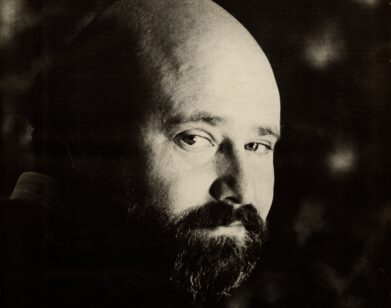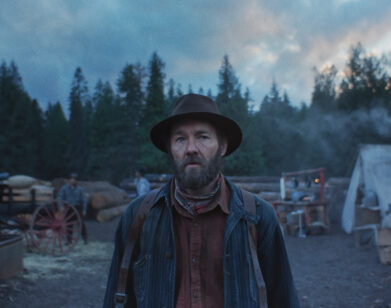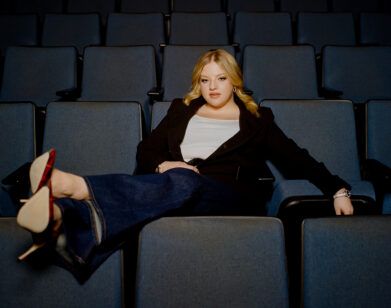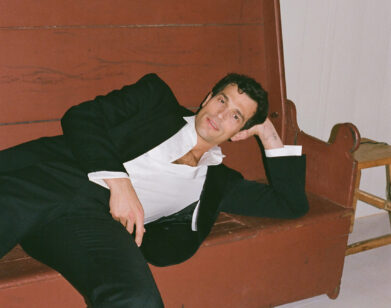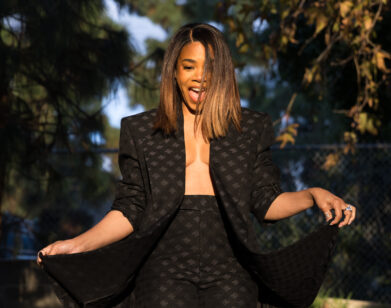The Limits of Neil Burger
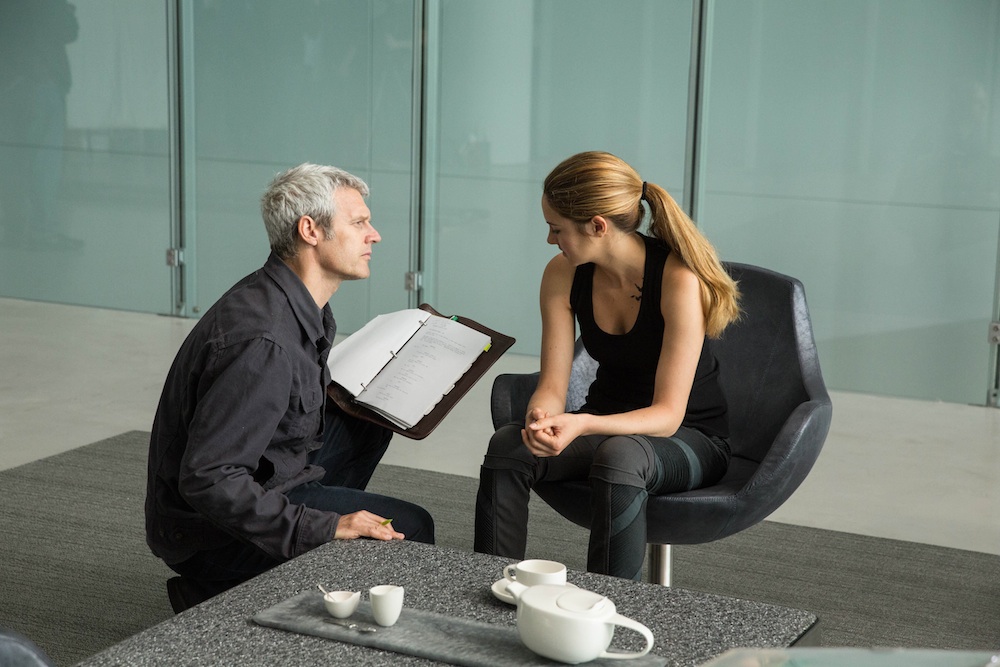
ABOVE: NEIL BURGER AND SHAILENE WOODLEY ON THE SET OF DIVERGENT. PHOTO COURTESY OF JAAP BUITENDIJK AND © 2013 SUMMIT ENTERTAINMENT, LLC.
“There is an old Hollywood adage: ‘It doesn’t matter if the movie is good or bad as long as you have five great scenes,’ ” says director Neil Burger over the phone. “Divergent has 20 great scenes, or more, that we’re trying to fit in.”
Based on the first book in a dystopian trilogy by young author Veronica Roth, Divergent follows Beatrice “Tris” Prior, a 16-year-old girl living in Chicago in the not-too-distant future. In Tris’ world, which does not extend past her city, people are divided into five factions based on the virtue they hold dearest: Abnegation (which prioritizes selflessness), Amity (kindness), Candor (honesty), Dauntless (bravery), and Erudite (intelligence). Anyone who does not conform is banished to the city outskirts as “factionless.” A person who values all five virtues equally, and who has the ability to do so, is known as “Divergent.”
As with many science-fiction films, it’s easy to make the premise sound convoluted, but Burger has a succinct summary on hand: “In a future society where you’re only permitted to be and do one thing in life,” he explains, “there’s a young woman who chooses to be different. And they’re going to kill her for it.”
“It’s not the first way I would think of dividing a society up,” Burger confides. “The book is an exploration of human nature, and it has this artificial construct of a society to explore those ideas.”
The Connecticut native began his career directing commercials, including the cult MTV campaign “Books: Feed Your Head.” Featuring famous actors of the time including Sherilynn Fenn, Timothy Hutton, and Aidan Quinn reading excerpts from the works of Anaïs Nin, Donald Barthelme, and Kafka, and intended to promote literacy, the series of shorts aired on MTV in the 1991. Divergent, which comes out this week and stars Shailene Woodley, Miles Teller, Ansel Elgort, Zoë Kravitz, and Ben Lloyd-Hughes, is Burger’s fifth feature film.
EMMA BROWN: How did you first get involved with Divergent? Did the studio approach you, or did you have to pitch to the studio?
NEIL BURGER: Right after Limitless (2011), I got sent a bunch of projects—books and scripts—and one of them was Divergent. I had a lot of things to read and I never actually got to it, but it was sitting on my desk for a number of months on the top of the pile. I would always walk by it and say, “I’ve got to get to that,” and I never quite did. Then somebody from Summit called me and said, “We have this script for this cool new movie coming in and we want you to take a look at it. It’s not quite ready but we’re giving you the heads-up.” I said, “Great. What’s it called?’ They said, “Divergent.” So I read the book and went from there. At first, I was a little bit reluctant. I thought, “Is this too close to some other projects—some other movies that are out there?” But then, something really struck me in it, and I was in. You still have to present your take on it, which I did.
BROWN: How did you start envisioning the film—did you start with the characters?
BURGER: First, I started thinking about the world and how I could do the world in an interesting way—have a vision for the movie that was different from other futuristic movies. I knew it was [set] in Chicago, and that was one of the ideas that unlocked the visual take on the movie: to use Chicago and do this futuristic movie using the monumental skyline in a very real way. Then I did start thinking of actors, particularly to play the part of Tris.
BROWN: Are aesthetics generally your point of entry into a film?
BURGER: I think so. I try to find the way to tell the story visually, which is an aesthetic idea, but it’s also a narrative idea as well. How is the camera going to move? What is it all going to look like? How is the audience going to see this story? Obviously the most important thing about the movie visually is creating this world. But the next interesting visual thing was the fear landscapes and all these psychological tests that the characters undergo. Whether it’s the aptitude test that’s going to determine what faction they join, or, once Tris is in Dauntless, the fear landscapes that are like controlled nightmares where you have to conquer your fear or you are going to be cast out of this faction. I had done some interesting psychotropic effects for Limitless, and so I wanted to take it to the next step: “What are your fears? What are the most intense things that are produced by that?” I already knew what would be in my own fear landscape, so I was interested in using that feeling of terror or paralysis.
BROWN: I heard that the film’s codename while your were shooting was “Catbird.” Is that true?
BURGER: Yeah it was, and then it changed to “Pound.” I don’t know why. I thought it was not a good choice of codename. We never found out who came up with that. We didn’t look that hard, but we were always like, “Who chose that?” Nobody would ever tell us.
BROWN: Shailene and Miles in particular are in quite a few films at the moment, but were there any cast members whom you discovered solely through the audition process?
BURGER: I would say two people. One of them was Christian Madsen, who plays Al, and who is fantastic. He has just the right kind of gentle giant quality to him. Then the other person, of course, is Theo James, who had been in a couple of things, but not much. That’s another thing that I’m really proud of—finding him a role where he could really shine. I think he could be a major movie star. He is just fantastic. He’s got such presence and is such a good actor and is this incredible fighter as well. He’s this powerful character that nobody’s seen before. In this movie, I found that when the right person walked through the door, you knew that they were the right person. [When] Theo came in we’d been looking for a while, and it was like, “Oh, thank god. Finally. Here’s this guy who’s this incredibly masculine and intense actor.”
BROWN: Did the fact that you wouldn’t be able to direct the second film, Insurgent, make you hesitate at all before accepting Divergent?
BURGER: For a minute I thought I was going to be able to do it. But [because of] how many characters there are, and how wide ranging the story is, it became clear that this was going to take a lot of editing and a lot of finessing to make this story work. I realized I can’t have half of my brain on the second movie and complete this movie in the style I want to. I didn’t have the bandwidth to be trying to work out that puzzle of the second book in the time available. At a certain point I had to let go, which was hard because I felt like I was giving birth to this story, at least cinematically, and I love working with these actors.
BROWN: I’ve been watching your old MTV literacy campaigns. Was that your first official directing job?
BURGER: I didn’t make any money on that, but that was the first thing where somebody gave me money. At the time it was not enough money, but it was a lot of money—each of those cost $16,000. Then, based on those, somebody asked me to make a commercial and I started doing these big-budget commercials. It was something that I never intended to do, but stumbled into. It made me a better director.
BROWN: Was the literacy campaign your idea?
BURGER: Yeah, I pitched the whole idea to MTV. It was an idea I had come up with with friends. MTV had such a high profile, as it still does, but at that time they were only really showing music videos. I was really interested in literature and wanted to share my passion. I had these ideas for these one-minute movies—these public service announcements promoting reading. MTV went for it, so I picked the stories and they weren’t really involved at all. We delivered them to MTV and they liked them and they won a bunch of awards, so it was a fun project.
BROWN: Did you always want to be a filmmaker?
BURGER: I always was drawing as a little kid. Not so much drawing a landscape or a still life, but drawing these worlds: the world of a battlefield, or the world inside a submarine. Just trying to see how all these things, places, and people fit together. Then, at a certain point, I got interested in set design for the theater. I was interested in architecture, but I was taking photographs at the same time, and architecture, though it had the design element, it didn’t have the narrative, emotional element that I was looking to do. I ended up painting for a while. I was dancing around it, and I realized that all these different interests came together in filmmaking.
DIVERGENT COMES OUT THIS FRIDAY, MARCH 21.

